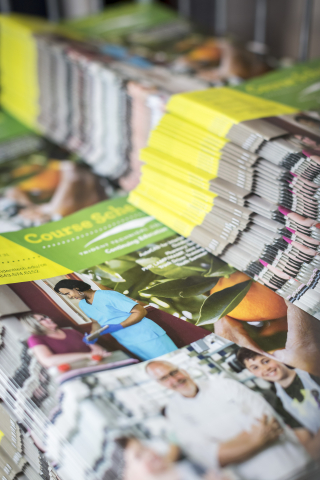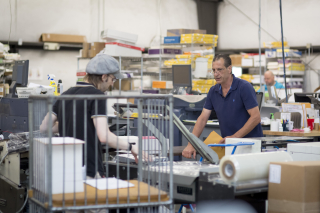Time is Money with Direct Mail
When Ben Franklin ran a print shop over two hundred years ago, it was hard work for the printer, and choices for the customer were limited – paper stock and size, a limited selection of fonts, and no choice about print color. Your job had to look good in black ink. That’s it – black ink.
In today’s world, however, choices about printing can be much more complex: these include multiple ways to print, a broad spectrum of colors, and a plethora of font and design choices. A good print shop will take your specs and print them just the way you ask. A great print shop, however, can help you through the decision-making process and offer expert time-saving, money-saving, and high-impact options for your print job.
At Ross Printing, Jeremy Ross wants to educate you in how to select the print options that will create effective and beautiful materials for your project or business. Options for printing include digital output and offset printing, in color or in black and white. Do you know which one to choose? It may depend on when you need the job, how many pieces you need, if the pieces need to be mailed, the content, the size of the stock, and other factors. When you think about all the variables in direct mail, it's easier to understand how time spent weighing your options will help you maximize the return on investment.
When do you need it?
Digital printing can be a much faster option than traditional offset printing. If you need the job done in a matter of days, digital is a great way to go; but if you have a little bit longer to get it done, say a week or more, then the job can be run on an offset press and you could save a significant amount of money.
Takeaway: Make it clear to the printer when you want the finished job and you can learn what options will save you the most money and have the highest impact.
How many pieces do you need?
 The size of the job can also help determine the best options. For some smaller jobs, digital might be a great option, giving you an affordable price and quick turn-around. For larger jobs, offset printing can offer significant price breaks for volume. “If the job is small enough, I can produce it more effectively doing it as a digital job,” Ross says. “Offset would wind up being more expensive. You know, if you said you needed a large number of pieces and we had enough time, I’d say that offset printing is most likely the way to go.”
The size of the job can also help determine the best options. For some smaller jobs, digital might be a great option, giving you an affordable price and quick turn-around. For larger jobs, offset printing can offer significant price breaks for volume. “If the job is small enough, I can produce it more effectively doing it as a digital job,” Ross says. “Offset would wind up being more expensive. You know, if you said you needed a large number of pieces and we had enough time, I’d say that offset printing is most likely the way to go.”
Takeaway: Make sure you explain to the printer exactly how many pieces you want printed.
Personalization
Studies have shown that the more personalized a direct mailing is, the more effective it is. Digital printing offers great options for merging personalized information such as names and addresses into the body of a printed piece. Of course, digital printing can be expensive for large volume, so there’s another option: combining offset with digital. Ross Printing can create a shell, an offset-printed printed piece that leaves space for personalized information to be printed digitally. “If we've got enough time to produce a shell,” Jeremy Ross explains, “we can produce the postcards in a more cost-effective way than doing them digitally, and then do a digital imprint on an offset printed shell."
Color? Black and white?
“Printing in color is great, but do you need it?” Ross asks. “We can help you save money by creating imprints that have high impact in black and white.” How? By changing font style and size and working with other elements of design. “And, of course, if color does matter, we can print in any color you want.”
How big?
The size of your finished materials can also help to determine the most cost-effective and impactful printing method for you. There are several factors to consider. First, how many pieces can be printed on one sheet of paper? If you can fit more on a sheet (and the printer will cut them), you can save considerably. If you need your printed material mailed, then postal regulations and envelope sizes become important factors. A great printer will consult with you on the design of the piece to help you produce finished sizes that are inexpensive, easy to mail, and look great.
What kind of paper?
 The options for paper stock can be confusing. Along with size options, there are all kinds of paper weights and textures, coated or uncoated, glossy or flat. Jeremy Ross explains: “Some customers might say, ‘A brochure-type paper.’ Well, I could print a brochure on anything. I might ask, ‘Are you looking for something kind of like a magazine cover?’ You know, I start giving them examples of, ‘Is this what you kind of had in mind? Do you want something that feels like a card stock or do you want something lighter weight?’”
The options for paper stock can be confusing. Along with size options, there are all kinds of paper weights and textures, coated or uncoated, glossy or flat. Jeremy Ross explains: “Some customers might say, ‘A brochure-type paper.’ Well, I could print a brochure on anything. I might ask, ‘Are you looking for something kind of like a magazine cover?’ You know, I start giving them examples of, ‘Is this what you kind of had in mind? Do you want something that feels like a card stock or do you want something lighter weight?’”
Ready to print?
If you are thinking about your direct mail project, the time to start is now. Ross Printing can get your job done quickly, but sometimes haste makes waste. If you take the time to consider your options and, with the help of a printing expert, plan in advance, you can have a direct mail campaign that will give you a competitive advantage. The best return on your printing investment comes from fine-tuning every aspect of target, design, production, and delivery.
